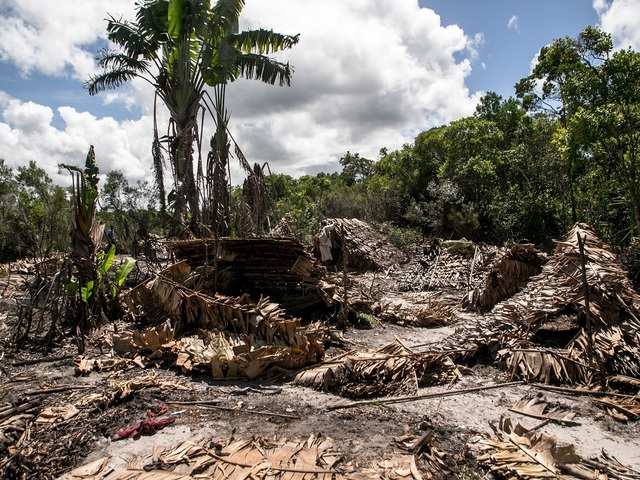 The world lost 12 million hectares of tropical forest in 2018, an area the size of England, new data from the University of Maryland reveals. According to the figures, released on April 25 by Global Forest Watch, this is the fourth-highest annual loss since records began in 2001.
The world lost 12 million hectares of tropical forest in 2018, an area the size of England, new data from the University of Maryland reveals. According to the figures, released on April 25 by Global Forest Watch, this is the fourth-highest annual loss since records began in 2001.The research group says that the disappearance of 3.6 million hectares of primary rainforest is of particular concern, since primary forests with old trees store more carbon than other forests and play an important role for biodiversity. Once cut down, these forests may never return to their original state. Despite a growing number of zero-deforestation commitments from governments and companies, primary rainforest loss hit record-highs in 2016 and 2017 and remained above historical levels in 2018. The main drivers are agriculture and the livestock industry, mining, infrastructure development and other commercial activities as well as fires.
Global Forest Watch highlights that the loss of primary rainforests differs from country to country. The main culprits in 2018 were Brazil, the Democratic Republic of the Congo and Indonesia. In 2002, just two countries (Brazil and Indonesia) made up 71% of tropical primary forest loss, whereas the latest data shows that this is changing. Brazil and Indonesia only accounted for 46% of primary rainforest loss in 2018, while the loss rates of other countries increased remarkably. In Brazil, 1.34 million hectares of primary forest were lost in 2018.
Commercial activities like ranching, mining, and soy production were reported as the main drivers. Brazil’s figure for 2018 was lower than its 2016-2017 fire-related spike, but still higher than it was between 2007 and 2015, when the deforestation rate fell by 70%. Global Forest Watch says that several hot spots of primary forest loss occurred notably near and within indigenous territories. For example, the Ituna Itata reserve saw more than 4,000 hectares of illegal clearing within its borders in the first half of 2018, more than double the total loss from 2002-2017. According to the research group, it is still too early to assess how the weakening of environmental laws and enforcement under Brazil’s new administration will impact forest loss.
In the Democratic Republic of the Congo, primary forest loss was 38% higher than it was from 2011-2017, reaching 481,248 hectares in 2018. Expansion of small-scale forest clearing for agriculture and fuelwood likely caused about three-quarters of this loss. Some loss patterns suggest that new, medium-sized agriculture and conflict-induced population displacement have also contributed. In Indonesia, 339,888 hectares of primary forest were cleared in 2018. Primary forest loss in the country dropped to its low
est rate since 2003 and was 40% lower in 2018 than the average annual rate of loss from 2002-2016. “The country saw an even more dramatic decline in forest loss in protected forests, suggesting that recent government policies are working. On peatlands deeper than 3 meters, which have been legally protected from development since 2016, forest loss dropped 80% from the 2002-2016 average,” Global Forest Watch wrote in their blog article. However, it is still too early to celebrate, since this year will be another El Niño year, which generally leads to dry conditions and a prolonged fire season in Indonesia, such as the one that burned 2.6 million hectares in 2015.
Several countries in South America experienced rising rates of primary forest loss since the turn of the century. In Colombia, 176,977 hectares of primary forest were lost in 2018. The loss increased by 9% compared to 2017, continuing a dramatic upward trend since 2016. “Ironically, this loss was related to the peace process, as areas in the Amazon previously occupied by the Armed Revolutionary Forces of Colombia (FARC) have opened up to development.
Tinigua National Park has been an unfortunate casualty of the rampant forest clearing, experiencing around 12,000 hectares of forest loss in 2018, 6% of its total forest area,” said Global Forest Watch. In Bolivia, most of the 154,488 hectares of forest loss was related to conversion of forests to large-scale agriculture and pasture, mainly in the Chaco. Forest loss in Peru (140,185 hectares), on the other hand, was generally for small-scale agriculture – including some illegal coca production. Peru also saw a proliferation of new logging roads in remote areas of the Amazon in 2018, as well as continued clearing for illegal gold mining. Although hundreds of countries and companies have made commitments to reduce deforestation by 2020 and some progress is made, the high rate of primary forest loss in 2018 suggests that we are not on track to meet these goals, Global Forest Watch warns. “Given the urgency to prevent runaway climate change and irreversible biodiversity loss, we need to rein in deforestation – before it’s too late.”





No comments:
Post a Comment